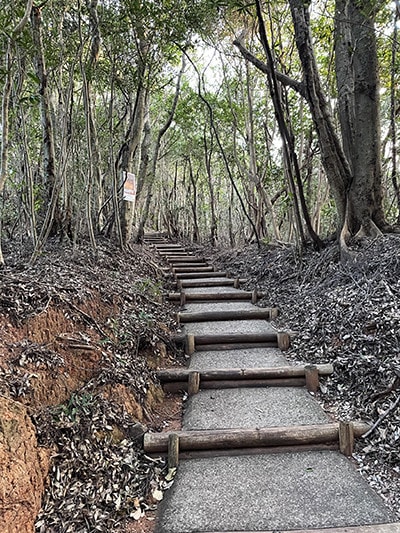



遣唐使という先進文化移植が日本国家の喫緊の課題だった時代。日本国家として世界での地位を確立していくためには、大陸中国国家から先進の技術や文化の導入が不可欠だったことでしょう。
建築では最新の仏教寺院建築が聖徳太子によって四天王寺や飛鳥寺、そして法隆寺など建立されていった。現代にまで朝鮮半島からの大工技術集団、日本最古の工務店・金剛組というカタチで生き残って存続している。仏教という宗教建築の仕様詳細が技術伝達され、在来の木造技術とフュージョンが巻き起こった。畿内地域でのこの先進技術が全国各地に「国分寺・国分尼寺」建設事業として推進され全国隅々まで重層的に技術文化拡散していった。
そういうなかで平安初期・大同元年(806)帰朝した遣唐使最大の「成功者」空海は未曾有の存在。当時の最先端仏教宗派、長安の青龍寺で師匠・恵果和尚から密教のコア秘法を習得し授かって「真言第八祖」となって帰朝した。そのことに日本社会は大きくどよめいたのだと思う。天才的な語学力と人間力で世界の文化中心のコアを鷲づかみして帰ってきたということだったのだろう。
現代でアナロジーするとすれば野球文化での大谷翔平君がいちばん似つかわしい。野球文化の最先端・大リーグを揺り動かすコアが日本人から生まれたという感覚。そういう存在が平安初期、国を挙げて文化導入に取り組んできた仏教界での空海という存在だったのではないか。


国を挙げてこの空海さんの快挙に対してそれを寿ぎ、賛同する空気が充満したのだろう。天皇もそのムーブメントを称揚し、中央政治も追随した。
当然、かれの出身地域・四国でも盛大なブームが起こり、いまに至る「八十八箇所」という文化が生成した。そういうなかで空海自身の体験、多少バイアスのかかった認知が、むしろ地域としては大きなアナウンス材料に変換されていったのではないか。
この青龍寺奥の院には空海が長安で投げた独鈷杵(とっこしょ)がこの地まで飛来したという伝承が伝わる。空海自身に放り投げ記憶があり「この思い、故郷に届け」というこころの叫びがこの地でフラッシュバックして、それが実際の風景に刻印された。青龍寺奥の院の崖地の老松に独鈷杵が「見えた」と感受したのでしょうか。本殿建築の奥の断崖から太平洋を見れば、樹間から朝日が昇っていくときの「キラキラ」がそのような体験を想起させることは自然にあり得るでしょう。
地元の人びとにとってはこういう空海さんの心中での「フラッシュバック」は恰好の「縁起」として説得力を持って受け入れられたことだろう。宗教が科学的認知に優先する時代であれば、理解できると思う。
English version⬇
Is Kukai the Shohei Otani of Heian Buddhism? Seiryu-ji Temple, the Inner Sanctuary of Seiryu-ji Temple-2
Ancient Japan was full of eagerness to introduce cutting-edge technology and culture. Kukai, a very successful man who appeared at the place where he studied abroad. This is a flashback. ...
This was a time when the urgent task of the Japanese nation was to transplant advanced culture in the form of Japanese envoys to the Tang Dynasty. In order for Japan to establish its position in the world, the introduction of advanced technology and culture from mainland China would have been essential.
In architecture, the latest Buddhist temple buildings were erected by Prince Shotoku, including Shitennoji Temple, Asukadera Temple, and Horyuji Temple. Even to the present day, a group of carpenters from the Korean peninsula, the oldest construction company in Japan, survived and continues to exist in the form of the Kongo-gumi. The details of the specifications of the religious architecture of Buddhism were transmitted, and fusion with native wooden construction techniques took place. This advanced technology in the Kinai region was promoted throughout Japan in the construction of Kokubunji and Kokubun nunnery temples, and the technology and culture spread in layers to every corner of the country.
In this context, Kukai, the most "successful" Japanese envoy to the Tang Dynasty, who returned to Japan in 806, the first year of the Daido Period in the early Heian period, was an unprecedented figure. He returned to Japan as the "Eighth Patriarch of Shingon," having learned and received the core secrets of esoteric Buddhism from his master, monk Keika, at Seiryuji Temple in Chang'an, the most advanced Buddhist sect at that time. I believe that Japanese society was greatly moved by this fact. He must have returned home with the core of the world's cultural center in his prodigious linguistic and human skills.
If we were to make an analogy today, Shohei Otani would be the most appropriate person to represent baseball culture. The core of the baseball culture, the core that shakes the big leagues, is born from a Japanese person. In the early Heian period, Kukai, a Buddhist monk, was probably the one who was involved in the national effort to introduce Buddhism to Japan.
The whole country must have celebrated Kukai's accomplishment, and an atmosphere of approval must have filled the air. The emperor also praised the movement, and the central government followed suit.
Naturally, Shikoku, Kukai's birthplace, also experienced a great boom, giving rise to the culture of "88 temples" that has continued to this day. In this context, Kukai's own experience and somewhat biased perception may have been converted into a major publicity material for the region.
The legend tells that the Tokkosho, or pestle, that Kukai threw in Chang'an flew to this place in the inner sanctuary of Seiryu-ji Temple. Kukai himself had a memory of throwing the pestle, and the cry of his heart, "Deliver this thought to my hometown," flashed back to him here, and it was imprinted on the actual landscape. He may have "seen" the Tokko pestle in an old pine tree on the cliff at the inner sanctuary of Seiryu-ji Temple. If you look at the Pacific Ocean from the cliff behind the main temple building, it is natural that the "sparkle" of the morning sun as it rises through the trees would evoke such an experience.
For the local people, this kind of "flashback" in Kukai's mind would have been convincingly accepted as a fitting "omen. In an age when religion takes precedence over scientific cognition, this would be understandable.

































